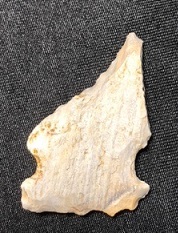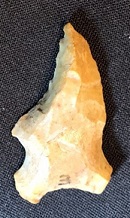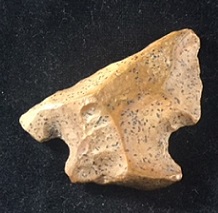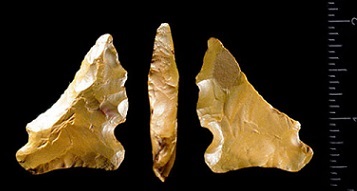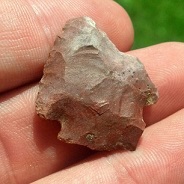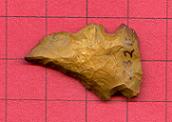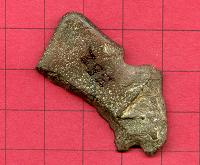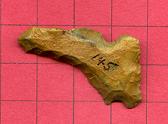Outline is Representative of Size and Shape:

Name Details:
Identified By: Clarence Webb
Named For: Type Site
Date Identified: 1946
Type Site: Albany Landing Site, Louisiana
Identified By: Clarence Webb
Named For: Type Site
Date Identified: 1946
Type Site: Albany Landing Site, Louisiana
Point Validity:
Valid type
Webb was a trained Pediatrician who became interested in archeology. In 1940 he became the charter member of the Society of American Archeology. He conducted many collaborative excavations and conducted his own excavations at Poverty Point and Gahagan Mounds. He was a well-respected Archaeologist. He named this point in a professional publication and this type has many professional references. This is a valid type.
Webb was a trained Pediatrician who became interested in archeology. In 1940 he became the charter member of the Society of American Archeology. He conducted many collaborative excavations and conducted his own excavations at Poverty Point and Gahagan Mounds. He was a well-respected Archaeologist. He named this point in a professional publication and this type has many professional references. This is a valid type.
Albany Spokeshave
AKA: Albany Bi-Face / Uni-FaceCluster:
Description of Physical Characteristics and Flaking Pattern:
This is a small to medium asymmetrical hafted scrapper with an elliptical cross section. The blade is asymmetrical with one blade varying from straight to slightly excurvate and the other blade being incurvate. Parallel side notches form shoulders that are horizontal to having an upward angle. The stem is expanded. The base may range from slightly concave to slightly convex. This scrapper has a random flaking pattern.
Size Measurements:
Commonly Utilized Material:
Additional Comments:
Clarence Webb first describes Albany Spokeshaves from artifacts found from the Albany Landing Site in Louisiana. Webb described two examples; 1. water smoothed flat pebbles that were side notched and beveled on one edge. 2. Possible reworked projectile points, which were beveled on one edge. Albany Spokeshaves are found at San Patrice sites and thought to be shaft scrapers.
Loyd Doty Reports: ALBANY KNIFE aka SCRAPER, SPOKESHAVE or GUT HOOK (Side Notch) – was named by Pediatrician and self taught archaeologist Clarence Webb for examples recovered from the type site near Albany Landing, Caddo Parish, Louisiana. They are small (1 ½ to 2”) hafted scrapers, knives or gut hooks that are part of the San Patrice took kit. Gut hooks were specialized knives used to cut open the stomachs of game. The Albany Knife may have been used on fish. The form also suggests that it could be used to scale as well as gut. They are asymmetric with steep beveling on one blade edge with rounded tip on the knife/scrapper form, or needle tip on gut hooks with a ground base. The Albany always has shallow crudely fashioned side notches whereas the Edgefield side notches are well done, deep and expanded to ‘E’ notches. The Albany were not salvaged projectiles, they are often uni-faced and were made in that form for a specific purpose(s). The Edgefield are salvaged or repeatedly sharpened knives.
Clarence Webb first describes Albany Spokeshaves from artifacts found from the Albany Landing Site in Louisiana. Webb described two examples; 1. water smoothed flat pebbles that were side notched and beveled on one edge. 2. Possible reworked projectile points, which were beveled on one edge. Albany Spokeshaves are found at San Patrice sites and thought to be shaft scrapers.
Loyd Doty Reports: ALBANY KNIFE aka SCRAPER, SPOKESHAVE or GUT HOOK (Side Notch) – was named by Pediatrician and self taught archaeologist Clarence Webb for examples recovered from the type site near Albany Landing, Caddo Parish, Louisiana. They are small (1 ½ to 2”) hafted scrapers, knives or gut hooks that are part of the San Patrice took kit. Gut hooks were specialized knives used to cut open the stomachs of game. The Albany Knife may have been used on fish. The form also suggests that it could be used to scale as well as gut. They are asymmetric with steep beveling on one blade edge with rounded tip on the knife/scrapper form, or needle tip on gut hooks with a ground base. The Albany always has shallow crudely fashioned side notches whereas the Edgefield side notches are well done, deep and expanded to ‘E’ notches. The Albany were not salvaged projectiles, they are often uni-faced and were made in that form for a specific purpose(s). The Edgefield are salvaged or repeatedly sharpened knives.
Distribution: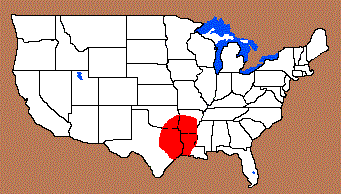
Distribution Comments:
This point is primarily found in eastern Texas and into western Louisiana. This point may be found into eastern Oklahoma and central Arkansas with decreased frequency.
This point is primarily found in eastern Texas and into western Louisiana. This point may be found into eastern Oklahoma and central Arkansas with decreased frequency.
Age / Periods:
Date: 10,000 - 7,000 B.P.
Cultural Period:Late Paleo to Early Archaic
Glacial Period: Early to Middle Holocene
Culture:
Date: 10,000 - 7,000 B.P.
Cultural Period:Late Paleo to Early Archaic
Glacial Period: Early to Middle Holocene
Culture:
Age Details:
Other points in this cluster / Related / Associated Points:
San Patrice
San Patrice

